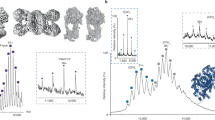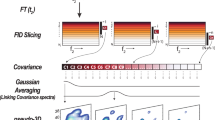Abstract
Magnetically aligned bicelles are an excellent medium for structure determination of isotopically labeled membrane proteins by solid-state NMR spectroscopy. Bicelles are a mixture of long- and short-chain phospholipids that form bilayers in an aqueous medium and align spontaneously in a high magnetic field, for example that of an NMR spectrometer with a 1H resonance frequency between 400 and 900 MHz. Importantly, membrane proteins have been shown to be fully functional in these fully hydrated, planar bilayers under physiological conditions of pH and temperature. We describe a protocol for preparing stable protein-containing bicelles samples that yield high-resolution solid-state NMR spectra. Depending on the details of the protein and its behavior in the lipids, the time for sample preparation can vary from a few hours to several days.
This is a preview of subscription content, access via your institution
Access options
Subscribe to this journal
Receive 12 print issues and online access
$259.00 per year
only $21.58 per issue
Buy this article
- Purchase on Springer Link
- Instant access to full article PDF
Prices may be subject to local taxes which are calculated during checkout


Similar content being viewed by others
References
De Angelis, A.A. et al. NMR experiments on aligned samples of membrane proteins. Methods Enzymol. 394, 350–382 (2005).
Opella, S.J., Ma, C. & Marassi, F.M. Nuclear magnetic resonance of membrane-associated peptides and proteins. Methods Enzymol. 339, 285–313 (2001).
Ketchem, R., Roux, B. & Cross, T. High-resolution polypeptide structure in a lamellar phase lipid environment from solid state NMR derived orientational constraints. Structure 5, 1655–1669 (1997).
Ram, P. & Prestegard, J.H. Magnetic field induced ordering of bile salt/phospholipid micelles: new media for NMR structural investigations. Biochim. Biophys. Acta 940, 289–294 (1988).
Sanders, C.R. II & Prestegard, J.H. Magnetically orientable phospholipid bilayers containing small amounts of a bile salt analogue, CHAPSO. Biophys. J. 58, 447–460 (1990).
Sanders, C.R. II & Schwonek, J.P. Characterization of magnetically orientable bilayers in mixtures of dihexanoylphosphatidylcholine and dimyristoylphosphatidylcholine by solid-state NMR. Biochemistry 31, 8898–8905 (1992).
Sanders, C.R., Hare, B.J., Howard, K.P. & Prestegard, J.H. Magnetically-oriented phospholipids micelles as a tool for the study of membrane associated molecules. Prog. NMR Spectrosc. 26, 421–444 (1994).
Smirnov, A.I. & Poluektov, O.G. Substrate-supported lipid nanotube arrays. J. Am. Chem. Soc. 125, 8434–8435 (2003).
Gaede, H.C., Luckett, K.M., Polozov, I.V. & Gawrisch, K. Multinuclear NMR studies of single lipid bilayers supported in cylindrical aluminum oxide nanopores. Langmuir 20, 7711–7719 (2004).
Lorigan, G.A. et al. Solid-state NMR spectroscopic studies of an integral membrane protein inserted into aligned phospholipid bilayer nanotube arrays. J. Am. Chem. Soc. 126, 9504–9505 (2004).
Chekmenev, E.Y. et al. 15N and 31P solid-state NMR study of transmembrane domain alignment of M2 protein of influenza A virus in hydrated cylindrical lipid bilayers confined to anodic aluminum oxide nanopores. J. Magn. Reson. 173, 322–327 (2005).
Hallock, K.J., Henzler Wildman, K., Lee, D.-K. & Ramamoorthy, A. An innovative procedure using a sublimable solid to align lipid bilayers for solid-state NMR studies. Biophys. J. 82, 2499–2503 (2002).
De Angelis, A.A. et al. High-resolution NMR spectroscopy of membrane proteins in aligned bicelles. J. Am. Chem. Soc. 126, 15340–15341 (2004).
Park, S.H., De Angelis, A.A., Nevzorov, A.A. & Opella, S.J. Three-dimensional structure of the transmembrane domain of Vpu from HIV-1 in aligned phospholipid bicelles. Biophys. J. 91, 3032–3042 (2006).
Durr, U.H.N., Yamamoto, K., Im, S.-C., Waskell, L. & Ramamoorthy, A. Solid-state NMR reveals structural and dynamical properties of a membrane-anchored electron-carrier protein, cytochrome b5. J. Am. Chem. Soc. 129, 6670–6671 (2007).
Triba, M.N., Devaux, P.F. & Warschawski, D.E. Effects of lipid chain length and unsaturation on bicelle stability. A phosphorus NMR study. Biophys. J. 91, 1357–1367 (2006).
Thomas, B., Cardon, T.B., Dave, P.C. & Lorigan, G.A. Magnetically aligned phospholipid bilayers with large q ratios stabilize magnetic alignment with high order in the gel and L phases. Langmuir 21, 4291–4298 (2005).
Prosser, R.S., Hunt, S.A., DiNatale, J.A. & Vold, R.R. Magnetically aligned membrane model systems with positive order parameter: switching the sign of S-zz with paramagnetic ions. J. Am. Chem. Soc. 118, 269–270 (1996).
Inbaraj, J.J., Cardon, T.B., Laryukhin, M., Grosser, S.M. & Lorigan, G.A. Determining the topology of integral membrane peptides using EPR spectroscopy. J. Am. Chem. Soc. 128, 9549–9554 (2006).
De Angelis, A.A., Howell, S.C. & Opella, S.J. Assigning solid-state NMR spectra of aligned proteins using isotropic chemical shifts. J. Magn. Reson. 2183, 329–332 (2006).
Vold, R.R., Prosser, R.S. & Deese, A.J. Isotropic solutions of phospholipid bicelles: a new membrane mimetic for high-resolution NMR studies of polypeptides. J. Biomol. NMR 9, 329–335 (1997).
Loudet, C. et al. Biphenyl bicelle disks align perpendicular to magnetic fields on large temperature scales. A study combining synthesis, solid-state NMR, TEM and SAXS. Biophys. J. 92, 3949–3959 (2007).
Gaemers, S. & Bax, A. Morphology of three lyotropic liquid crystalline biological NMR media studied by translational diffusion anisotropy. J. Am. Chem. Soc. 123, 12343–12352 (2001).
Nieh, M. Magnetically alignable phase of phospholipid 'bicelle' mixtures is a chiral nematic made up of wormlike micelles. Langmuir 20, 7893–7897 (2004).
Nevzorov, A.A., De Angelis, A.A., Park, S.H. & Opella, S.J. in NMR Spectroscopy of Biological Solids (ed. Ramamoorthy, A.) 177–190 (CRC Press, Boca Raton, FL, 2005).
De Angelis, A.A., Howell, S.C., Nevzorov, A.A. & Opella, S.J. Structure determination of a membrane protein with two trans-membrane helices in aligned phospholipid bicelles by solid-state NMR spectroscopy. J. Am. Chem. Soc. 128, 12256–12267 (2006).
Park, S.H. et al. High-resolution NMR spectroscopy of a GPCR in aligned bicelles. J. Am. Chem. Soc. 128, 7402–7403 (2006).
Schagger, H. Tricine-SDS-PAGE. Nat. Protoc. 1, 16–22 (2006).
Dvinskikh, S.V., Durr, U.H.N., Yamamoto, K. & Ramamoorty, A. High-resolution 2D NMR spectroscopy of bicelles to measure the membrane interaction of ligands. J. Am. Chem. Soc. 129, 794–802 (2007).
Dvinskikh, S.V., Yamamoto, K., Ulrich, H.N., Dürr, U.H.N. & Ramamoorthy, A. Sensitivity and resolution enhancement in solid-state NMR spectroscopy of bicelles. J. Magn. Reson. 184, 228–235 (2007).
Acknowledgements
These studies were supported by research grants RO1EB 001966, RO1GM075877 and RO1EB005161, and utilized the Resource for NMR Molecular Imaging of Proteins, supported by grant P41EB002031 from the National Institute for Biomedical Imaging and Bioengineering. A.A.D.A. was supported by postdoctoral fellowship F32GM65833.
Author information
Authors and Affiliations
Corresponding author
Rights and permissions
About this article
Cite this article
De Angelis, A., Opella, S. Bicelle samples for solid-state NMR of membrane proteins. Nat Protoc 2, 2332–2338 (2007). https://doi.org/10.1038/nprot.2007.329
Published:
Issue Date:
DOI: https://doi.org/10.1038/nprot.2007.329
This article is cited by
-
1H-31P home-built solid-state NMR probe with a scroll coil for 400-MHz NB magnet for biological lossy sample
Journal of Analytical Science and Technology (2020)
-
Versatile formation of supported lipid bilayers from bicellar mixtures of phospholipids and capric acid
Scientific Reports (2020)
-
The dynamics of the G protein-coupled neuropeptide Y2 receptor in monounsaturated membranes investigated by solid-state NMR spectroscopy
Journal of Biomolecular NMR (2015)
-
Oriented samples: a tool for determining the membrane topology and the mechanism of action of cationic antimicrobial peptides by solid-state NMR
Biophysical Reviews (2015)
-
Resonance assignments of a membrane protein in phospholipid bilayers by combining multiple strategies of oriented sample solid-state NMR
Journal of Biomolecular NMR (2014)
Comments
By submitting a comment you agree to abide by our Terms and Community Guidelines. If you find something abusive or that does not comply with our terms or guidelines please flag it as inappropriate.



